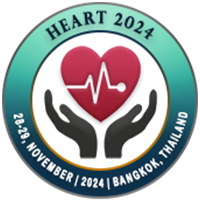
Lyudmila Khidirova
Novosibirsk State University, RussiaTitle: Cardiometabolic and hemodynamic features in elderly and senile patients with comorbidity who underwent COVID-19
Abstract
Introduction. Since the second half of January 2023, there has been a downward trend in the number of people infected with the SARS-CoV-2 virus, but at the same time, the number of people with long-term consequences of the novel coronavirus infection COVID-19 and verification of the “state after COVID-19” is increasing. Target. To study cardiometabolic and hemodynamic features in elderly and senile patients with comorbid pathology who have undergone a new coronavirus infection. Methods. The study included 154 male and female patients with arterial hypertension (AH), coronary heart disease (CHD) and type 2 diabetes mellitus (DM) aged 60-89 years. The patients were comparable in frequency and nature of comorbid nosologies and were divided into 2 groups: the first - 79 patients (mean age 68.29 ± 6.48 years) without a history of coronavirus infection caused by SARS-CoV-2 and the second - 75 patients (mean age 67.89 ± 6.42 years) with a history of SARS-CoV-2 infection. Clinical (blood pressure (BP), heart rate (HR), six-minute walk test to assess the functional class of heart failure), laboratory (blood lipid spectrum, fasting blood glucose, glomerular filtration rate (GFR), NT-proBNP) were evaluated . Statistical data processing was carried out in the RStudio program. Results. Patients with post-COVID syndrome (PCS) had higher values of a number of biochemical parameters: total cholesterol (5.44 [4.78; 6.9] and 5.02 [4.05; 5.76] mmol/l (p=0.008)), LDL cholesterol (3.11 [2.57; 4.58] and 2.57 [1.95; 3.11] mmol/l (p˂0.001)), TG (2.5 [1.53; 4] and 1.5 [1.09; 2.47] mmol/l (p˂0.001)), fasting plasma glucose 8 [6.65; 11] and 5.7 [5.25; 7.1] mmol/L (p<0.001)), lower CKD-EPI GFR values (63.8 [57.45; 78.34] ml/min/1.73m2 and 70.7 [62; 77.18] ml/min/1.73m2 (p =0.003)). Also in the second group, there were lower diastolic BP (58 [40; 74] mm Hg and 76 [69; 82] mm Hg (p < 0.001)), and higher systolic BP (154 [ 141; 165] mm Hg, and 150 [143; 165] mm Hg (p=0.009)). The median heart rate in patients with PCS was 77 [73; 80], and in patients in group 1 - 75 [67; 77] beats per 1 minute (p=0.002). FC III CHF (NYHA) was detected in 45.3% of patients in the group with PCS, and in 22.8% (p=0.004) in the first group. The level of NT-proBNP was expectedly higher in patients with PKD (128.05 [85.12; 245.21] and 88.4 [38.85; 131.85] pg/mL (p<0.001)). Conclusions: in patients who underwent a new coronavirus infection, in comparison with patients comparable in terms of comorbid diseases and age without a history of SARS-CoV-2 infection, adverse cardio-metabolic and hemodynamic features were registered, consisting in the presence of atherogenic dyslipidemia, diabetic hyperglycemia, and a higher incidence of clinical and laboratory markers of advanced CHF, increased pulse blood pressure and heart rate.
Biography
Lyudmila Khidirova completed her PhD at Novosibirsk State University, Russia at the age of 50. He is a professor at the Department of Evidence-Based Medicine and Clinical Pharmacology. She has more than 150 publications, which have been cited about 300, and the h-index is still 7. She is a member of the Russian Cardiology Society and the editorial board of the journal.

